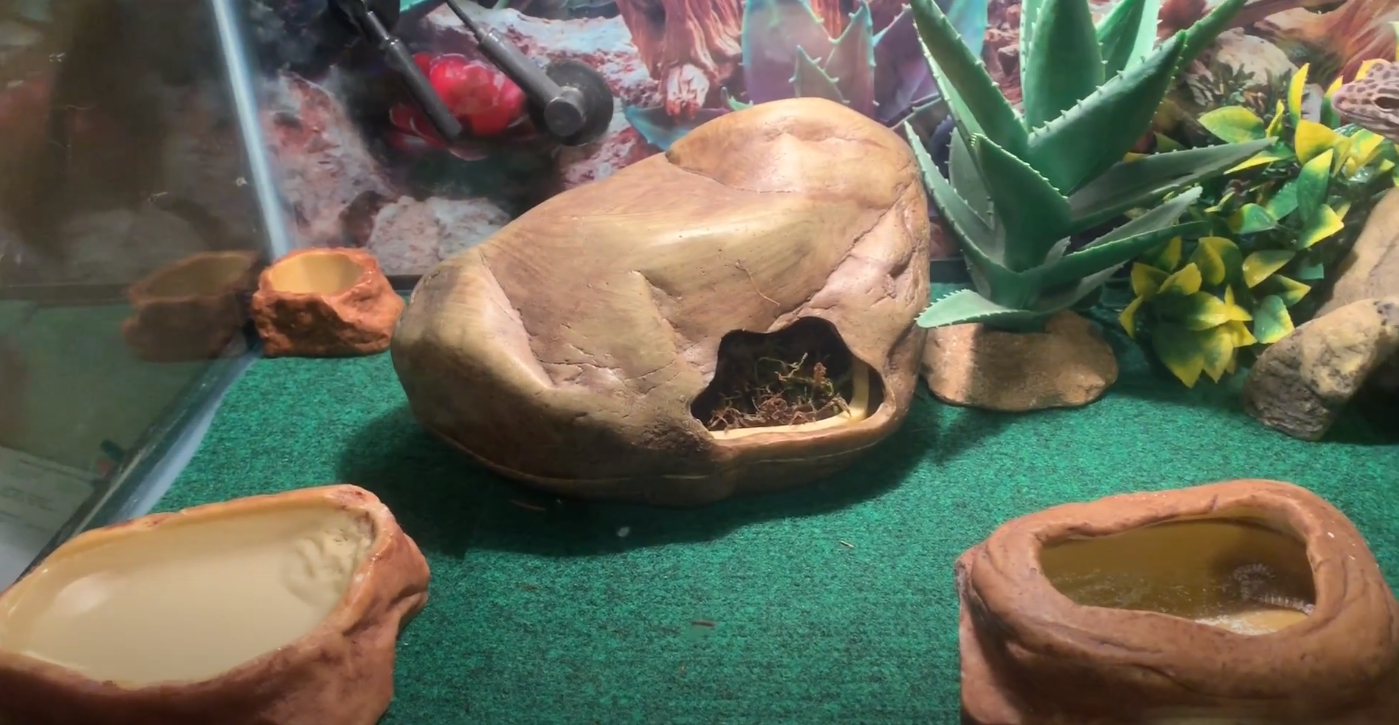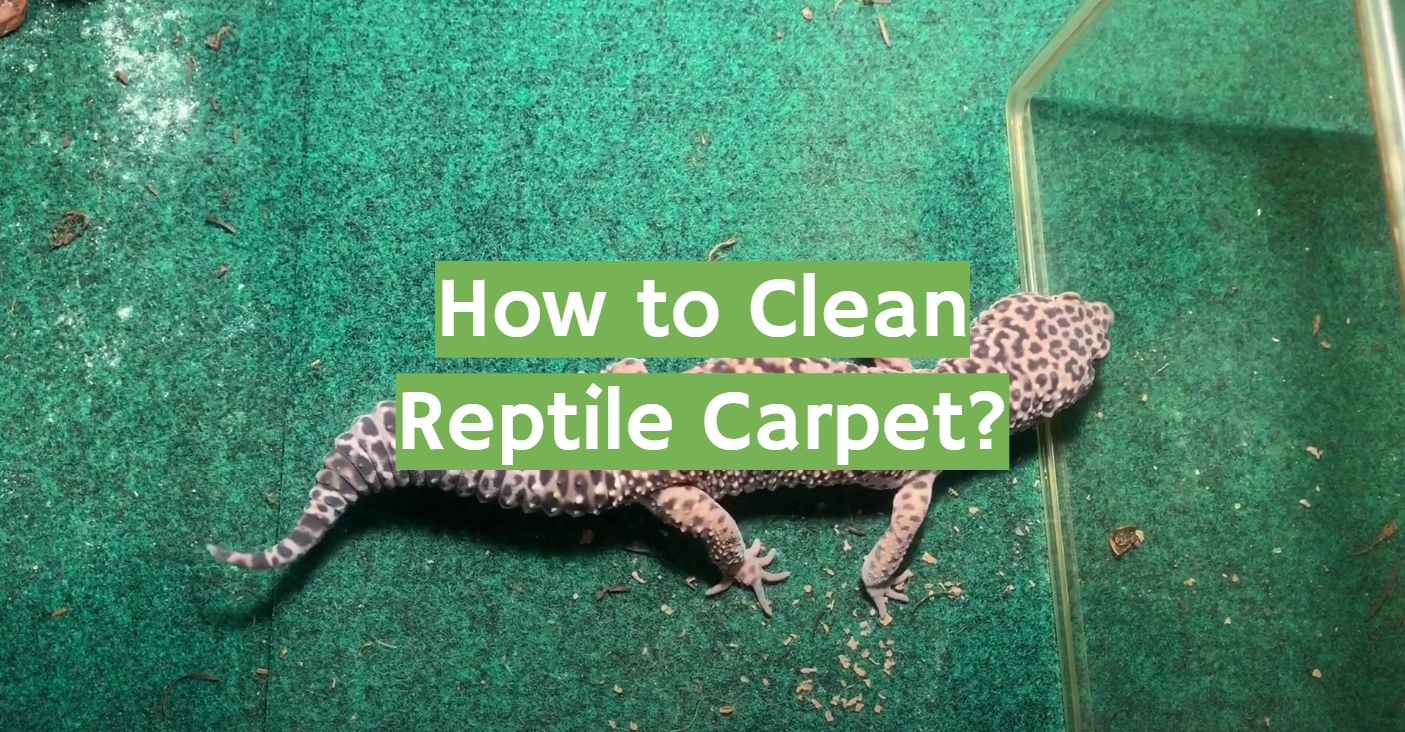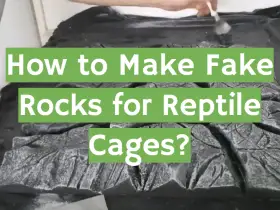A reptile carpet is a synthetic, non-absorbent material that can be used as an alternative to sand and soil substrates. It’s often used for desert reptiles who live in the wild on top of flat rocks. Reptile carpet is also used for reptiles who need to have a moist hiding area.
Many people have a love for reptiles, and one of the most popular types is lizards. They are not as easy to take care of as other pets, but they do require a lot less attention than cats or dogs. One thing that many reptile owners find difficult is cleaning their carpets. This article will give you some simple steps on how to keep reptile carpets clean without harming your pet!
What You’ll Need?
- Water and dish soap;
- Bucket;
- Rag or sponge;
- Scrub brush;
- Paper towel;
- Disinfectant;
- Special reptile carpet cleaner (optional);
Step-By-Step Instructions
Prepare Your Area
The surface where you’ll be cleaning your carpet in a reptile cage must be flat and free of any objects if possible so that it doesn’t become damaged while you’re scrubbing the stains away from this area with a brush.
Also, make sure to place old towels or sheets around this workstation before beginning. They’ll come into play later on when needing them for rinsing off dirty water after washing your carpets or walls inside their enclosures will help keep everything clean rather than having excess soap all over the floor which can also cause problems down the line if not taken care of properly since these chemicals aren’t good for them either.

If at all possible avoid placing anything breakable near this space too such as vases or plants that have been in the space for a long time because these things can get knocked over and broken while you’re scrubbing away at dirty carpet stains so it’s best if you keep them somewhere else during this process.
Make sure to turn off any fans from being on near where you clean your carpets too since they could blow around water droplets which might cause damage to whatever is sitting underneath of them. Also, shutting off all vents will prevent moist odors from coming up into other areas of your home while working on these tasks.
A lot of people like using fabric softener sheets when washing clothes but don’t do this with reptile carpets because bedding made for reptiles is very absorbent and can hold onto the chemicals in fabric softener sheets which will damage them over time when used frequently.
Wipe with Paper Towels
Use paper towels to first wipe away any large debris that is sitting on top of your carpet like bugs or droppings.
Scrub with Soap & Water
Once the surface is cleared of any larger particles that are visible to the naked eye, you can then mix up a solution with water and dish soap in your bucket that will help break down more stubborn stains.
Be sure to use reptile carpet cleaner for this purpose. Because it won’t damage carpets but regular old household cleaning products may cause some problems if not taken care of properly since they aren’t made specifically for these purposes like most cleaners are created for home or commercial usage instead of being designed specifically with reptiles in mind. It means their chemical makeups could potentially be harmful to them too so keep this in mind before trying out new things on your own while washing away dirt, grime, mold growths, or other types of stains from their enclosures.
Once you’ve got the right kind of soap for this process, pour a small amount into your bucket and then mix it up with water to create a mixture that is roughly half dish liquid and half clean water. If at all possible try not to use hot or boiling water because reptiles can’t handle extreme temperatures as well as humans which means they might be subjected to burns on their skin when exposed to these kinds of temps so using lukewarm tap water will work just fine in most cases.
While scrubbing away at stubborn dirt patches, grime buildups or other things like mold growths inside reptile cages, make sure you have towels around for rinsing off dirty water that can be used later on when cleaning their enclosures. So you don’t have to worry about anything getting too moist inside of these areas which could cause problems with mold growths or other types of bacteria staying around in the enclosure.
Make sure not to scrub too hard because this might damage your carpet by snagging it and pulling out tufts of fibers from underneath, causing them to fray apart after repeatedly thumping against them for a long time. Just use light pressure while working away at stains where necessary but try your best not to put more than enough stress on fabrics that are made for reptiles since they aren’t as durable as our own carpets would be under similar circumstances.
Rinse Bucket
After you’re done scrubbing away at your carpets, change out the old dirty water with clean water in order to rinse it out completely before putting this mixture down into a drain or outside where pets can’t get inside of it.
You could also use paper towels again for rinsing off any leftover soapsuds that might be sticking around after using this method. Don’t put too much pressure on these kinds of towels either because they are made from weaker fibers than regular washing machine fabric which means they will rip apart if exposed to too much stress and pulling motions like laundry would under similar circumstances.
Rinse with Water Again
After you have rinsed off any soap residue that is still hanging around your carpet, it’s time to go ahead and rinse the whole thing out with water once more so it can be scrubbed clean of mold growths or other types of stains without leaving too much behind.
Don’t use dish liquid again at this point because you don’t want these chemicals being left up against surfaces where reptiles could potentially come into contact with them which might cause problems for their health if they are exposed to chemical irritants like those found in detergents.
Instead, make sure the only kind of cleaning mixture used here contains nothing but hot water since this will help kill bacteria or anything else that may be lingering inside enclosures after being scrubbed away with other kinds of chemicals.
Spray with Disinfectant
Once you have finished rinsing away at your carpet with clean water, spray down the whole area with a disinfectant that is made for getting rid of bacteria or other types of germs that may be lingering around.
Most pet stores will carry these kinds of cleaners in bottles or aerosol cans so just look around inside their store to see what they’ve got before moving forward; make sure not to use bleach because it’s corrosive when combined with fabrics like carpets which means this could potentially cause damage if used on them instead.
After spraying down any areas where mold growths are still lurking after scrubbing out stains and grime buildups too, allow enough time for this cleaner to completely dry up before putting your reptiles back in their cages so they don’t accidentally lick these chemicals off of their carpets which could cause problems later on.
Let it dry
Once you’re done cleaning out your reptile carpet, leave it hanging up somewhere where pets can’t get to it while it’s still wet so mold growths or other problems won’t have a chance to start since this part takes the longest amount of time compared to everything else involved in this process.
You’ll want to make sure these surfaces are completely dry before putting them back inside enclosures again because reptiles like warm places above all else when they need shelter.
If you put their carpets back into enclosures after washing and drying them but aren’t able to heat these areas up enough using lamps or anything similar then there is no point in putting things back together since they will just want to go back outside.
You could also wait a little longer before putting their carpets inside of enclosures after washing and drying them. So you have more time to let surfaces dry completely without having reptiles coming into contact with damp areas that might cause problems for their health if they aren’t allowed enough time to dry out properly since this whole process takes quite some time due to the amount of water involved in it.
Repeat At Least Once Per Week
Repeat this process at least once per week to help keep your carpets clean, especially if you have reptiles living inside of them who are likely to track in dirt or other types of grime in various places around their enclosures.
Make sure not to use harsh chemicals on any surfaces where your pets may face these toxins because they could cause problems for their health unless used sparingly. If you notice that stains are still hanging around after using water and vinegar mixtures then it might be time to buy stronger cleaning solutions from pet stores instead.
Easy-to-follow-Simple Steps to Clean Reptile Carpet Instantly
Cleaning Tools and Accessories
Prepare loth, paper towels, and warm water.
Before cleaning, use warm water to rinse the carpet. Make sure that no soap residue is left behind as this would damage your pet’s skin or eyes problems. In case of emergency situations such as stuck food particles in between the fibers – you can try using a damp cloth with a mild detergent solution for spot cleaning only!
A dry clean sponge works well for removing dirt from crevices. Always avoid strong chemicals like bleach or disinfectants that might cause irreparable damages to the reptile. If stains persist, take the help of professional cleaners who know about these things better than anyone else does.
Cleaning Schedule
The number of reptiles you own should determine a good cleaning schedule for your reptile carpet.
If you have more than one pet, then it is important to clean the reptile carpet at least once a week or month (depending upon how often they shed their skin).
Dirty carpets can cause bacteria growth which could lead to several health problems like respiratory disorders and microbial infections. The intensity of dirt also determines the frequency of cleaning scales up with increased shedding frequency as well as high-traffic areas where fecal matter might accumulate easily.
Is it necessary to clean the reptile carpet after every time he poops?
No, it is not necessary. Cleaning the reptile carpet after every time he poops can cause stress and anxiety to your pet. However, you need to thoroughly clean the area twice a week at least – one day before and on the same day as your snake’s feeding session. Cleaning these areas would help prevent bacteria from growing which may lead to diseases in reptiles such as salmonella poisoning or E Coli infections. This way you will also save yourself from cleaning up messes later!
FAQ
Is reptile carpet just felt?
Reptile carpet is a type of felt that is made from 100% recycled materials. It has no fibers, chemicals, or toxins.
Can I put reptile carpet in the washing machine?
Reptile carpets are made of natural fibers, so you can wash them in the washing machine. It is important to read the care label before putting it in there. You need to use cold water and turn off any spin cycle that may be on your washer if one exists. After washing, lay it out flat or hang dry for best results.
How often should I clean my reptile carpet?
Cleaning reptile carpet is a relatively easy process that only takes a few minutes of your time. It’s important to clean the cage regularly so that you can avoid any potential health issues for your pets and ensure they stay healthy!
The recommended cleaning schedule will depend on how often you feed them, but it should be every 1-2 weeks depending on what type of diet your pet eats. If there are frequent messes or messy foods in their enclosure such as live crickets then it may need more regular cleaning.
Is reptile carpet easy to clean?
Yes, it is. It should be kept clean to keep your pet healthy and happy. Reptile carpet will need to be cleaned if your pet has an accident or spills something on it. The easiest way is through spot cleaning with a damp rag and some soap.
If the spill is bad, you can use bleach to clean it up safely. Just put some bleach in water before putting it into the washing machine so that there are no harmful fumes for pets or humans. As long as you keep the dirtiest part of the reptile carpet at least two inches from other areas, then all should be good!
How do I clean my bearded dragon’s carpet?
Bearded dragons require a certain type of substrate for their enclosure. Their carpet is often made from several layers and types of materials that will need to be cleaned once every week or two depending on how many bearded dragons you have and if they’re producing eggs.
If your reptiles are laying eggs, then the substrate should be completely replaced after the hatchlings leave the nest as it can carry diseases harmful to those who eat them such as Salmonella that causes diarrhea in humans even when cooked so it’s best not to ingest these new pets!
Can you clean the reptile carpet with vinegar?
Yes. You can clean the reptile carpet with vinegar, but only if you do not mix it in water. Use a paintbrush to scrub off dead skin cells and dust on your pet’s body or tail scales. The best way to get rid of the smell is by using baking soda since it absorbs odor instead of masking them like other perfumed products for pets do.
Is Dawn dish soap safe for reptiles?
Dawn dish soap is not safe for reptiles and it should never be used to bathe them. It can cause damage to their scales, skin, eyes, and ears when applied directly or when ingested during the cleaning process.
Is reptile carpet waterproof?
The reptile carpet is usually not waterproof. It’s a good idea to use a sealer before setting up the tank and then let it dry completely, which can take several days or more depending on humidity levels in your home. Make sure that you have read the specific instructions for any products used as well as how long they need to dry before adding reptiles.






Leave a Review